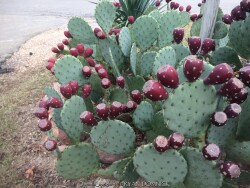

The yellow flowers, maroon long lasting fruits, and upright growth habit of this cactus (Opuntia engelmannii var. lindheimeri) create a unique addition to the desert garden. The pads are sparsely spined, light green, and hardy to about -5 degrees F. Native to arid soils in Texas and Oklahoma, this cactus has a place as one of the few upright cacti that can handle extreme cold. In fact, I have seen this species growing a in Lawrence, KS in desert gardens along a south wall of a house. With well drained soils and proper micro-climate, this cactus can handle our extreme cold and excess rainfall of Eastern Kansas.
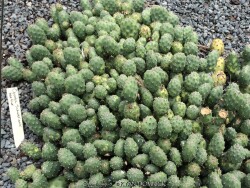

These tiny perennial succulent cacti (Opuntia fragilis 'Potato') produce globe-shaped, spherical stems make this selection unique. 'Potato' prickly pear is virtually spineless. It is native to mountainous areas in Western Colorado. The olive green "pads" take on a lovely winter blush of purple in cold weather. Grow this small native gem in a Kansas rock garden, in cracks between rocks, or on top of or in a retaining wall. You may also grow in flat areas like in between stepping stones provided you used a gravelly or sandy base for the stones. It will not tolerate rich moist soils as other plants or weeds will shade it out. Root rot can occur during lengthy hot humid summer rainy periods. If grown as a summer patio plant, move to a bright interior window over the winter before extreme cold occurs with no watering and keep above freezing. As a winter-only house plant, it will look presentable all winter long with just no waterings. Upon moving outside the following spring, plants with plenty of time to acclimate will thrive in full sun but be careful not to rush it or sunburning will occur. Generally if moving outside for the summer, allow 2-3 weeks of part shade or morning sun before placing in full sun. If grown in pots permanently outdoors, keep on the dry side in minerally sandy soil. You may leave out all winter allowing to freeze solid (Hardy to zone 4a); plants will go dormant and resume growth in the spring. As a permanent house plant, provide bright light and allow the soil to dry between waterings for many years of carefree enjoyment. Little potato-like pads are easy to propagate. Our original plant came from Plant Delights Nursery in North Carolina and also available on their mail-order website.
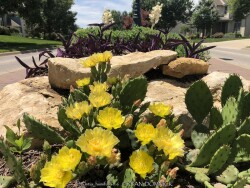

Eastern Prickly Pear Cacti (Opuntia humifusa) have attractive green pads, brilliant yellow flowers in June, and pinkish maroon edible fruits afterward that last into winter. They are native to eastern woods of Kansas, Missouri, Oklahoma, Texas, Arkansas and much of the Southeast United States. This cold hardy succulent occupies an unusual niche: growing in poor shallow sandstone based soils in open woods and on sunny rock cliffs that dry out too quickly for most other plants to colonize. Pads are sometimes carried off by animals and take root elsewhere. Grow this small native gem in rock gardens, dry shade areas, in parking lot medians, in cracks between rocks, or on top of or in a retaining wall. This species will grow in full sun or full shade! Although not picky about soils, just ensure that drainage is good. If grown in exterior pots and kept on the dry side, you may leave out all winter allowing to freeze solid; plants will go completely dormant and resume growth in the spring. Although these prickly pear do not have spines, they do have glochids. (painful bristles that come off and irritate the skin for a few days) Great low maintenance cold hardy and very versatile succulent.


Plains Prickly Pear Cacti (Opuntia macrorhiza) have attractive green pads, brilliant yellow flowers in June, and pinkish maroon edible fruits afterward that last into winter. They are native to much of the Great Plains from Texas to Minnesota. Pads are sometimes carried off by animals and take root elsewhere. Grow this small native gem in rock gardens, dry shade areas, in parking lot medians, in cracks between rocks, or on top of or in a retaining wall. Although not picky about soils, just ensure that drainage is good. If grown in exterior pots and kept on the dry side, you may leave out all winter allowing to freeze solid; plants will go completely dormant and resume growth in the spring. Although these prickly pear have spines and glochids. (painful bristles that come off and irritate the skin for a few days) so be careful around children and pets. Great low maintenance cold hardy and very versatile plant!
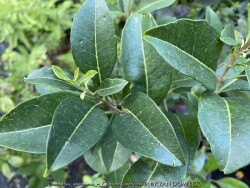

Devilwood (Osmanthus americanus / Cartrema americana) has very hard and dense wood, hence the name. It is a slow-growing evergreen shrub or small tree native to southeastern North America and Mexico. Bright green simple leaves emerge in spring turning deeper green in summer. Cream white flowers borne on separate trees and female trees produce abundant blue/black fruit. Growth habit is somewhat open so don't count on it to provide screening or density. Grows in sun or shade but in the northern part of its range, growth is too slow and sparse in the shade. Devilwood grows in most soils including moist ones and occasional flooding. This making it an ideal rain garden plant. Becoming more drought tolerant when established, our 40 inches of typical rainfall in Eastern Kansas is sufficient if planted in good soils. The cold hardiness is surprising: as a zone 5, this could be one of the most cold-tolerant broadleaf evergreens trees available! It survived -16 degrees F and a week of single digit highs in February, 2021 with no damage. It even maintains bright green foliage in winter opposed to a dingy brownish-green like some evergreens. Useful in the garden as a background evergreen shrub or small tree. Sold as Osmanthus americanus, Cartrema americana is technically it's new botanical name.
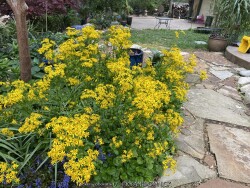

Native Roundleaf Groundsel / Packera, is also known as Packera obovata
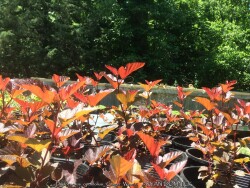

Ginger Wine® Ninebark (Physocarpus opulifolius 'Ginger Wine') expands the color palette for these easy care, native flowering shrubs. Spring foliage emerges a sunny orange color and matures to sparkling burgundy. Clusters of white flowers cover the plant in late spring, and these age to attractive red seed heads. This disease-resistant shrub does best in full sun locations and cooler climates. Top reasons to grow Ginger Wine® ninebark: 1.Colorful from spring through fall. 2. Native to North America. 3. Very low maintenance: no pruning or deadheading required. Ultra cold-hardy plants from northern climates normally dislike our long hot humid summers; although we are on the Southern edge of this plants adaptability, it still survives reasonably well here. It will not handle extreme drought; the Lawrence KS summer of 2011 and 2012 killed many plants that were not under an irrigation system. Look for a cold microclimate planting location such as East or North exposure but still in full sun. All Proven Winners® plants are legally propagated, healthy and vigorous, true to name, and tagged with color pictures and growing information.
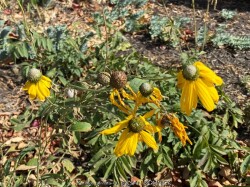

***Description for this perennial available with future update!*** Mexican Hat, is also known as Ratibida columnifera
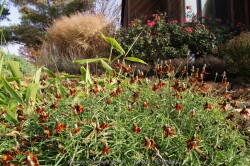

Red Mexican Hat, is also known as Ratibida columnifera 'Red'
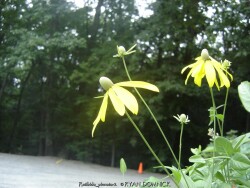

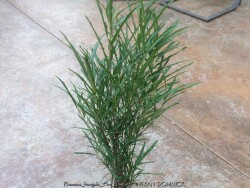

Fine Line Columnar Buckthorn, is also known as Rhamnus frangula 'Fine Line'


Fine Line Columnar Buckthorn, is also known as Rhamnus frangula 'Fine Line'
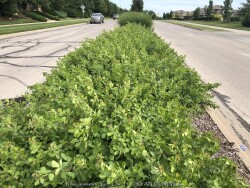

Gro-low sumac (Rhus aromatica 'Gro-low') is a dwarf spreading cultivar of Rhus aromatica native to much of the central United States including Kansas. It features bright green leaves that turn brilliant red in the fall. Light yellow flowers and occasional red berries are also ornamental features. This sumac is commonly grown as a spreading groundcover shrub for difficult areas. It will grow in full sun or full shade in medium to dry soils including dry-shade. However, fall color is quite a bit reduced in full shade. In the landscape, it is commonly used as large mass planting on hills. Because of its tolerance for adverse conditions including poor soil and rock, it is often one of the last resort plants that will survive in certain areas. It competes well under large shade trees and helps absorb leaf litter allowing it to break down and add nutrients back to the soil. It is important to keep on the dry side to discourage root rot disease. This plant also does well in hot dry parking lot islands or along busy roads. Plants adapt well to hot south or west sides of the house enduring temperatures of over 100 degrees F with no foliage burn. Plants can also be planted on the north side of a house being extremely cold hardy with no winterkill. Another great spot is planting on top of a retaining wall allowing it to cascade down. We do not recommend planting in small areas or in spaces that it will overrun neighboring plants. Unlike other sumac, it only spreads above ground as horizontally growing stems touch the ground and root. This does make maintenance easier to control the spread of the plant versus digging out rhizomes. Considered one of the most versatile and best plants for solving your most difficult landscape challenges.
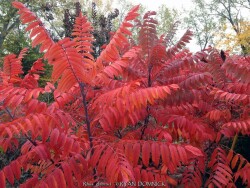

>>>>>Smooth Sumac (Rhus glabra) features bright green leaves that turn brilliant red in the fall. Light yellow flowers and occasional red berries are also ornamental features.>>>>>>It will thrive in full sun in medium to bone dry soils. In the landscape, it is commonly used as large mass planting on hills and berms. Because of its tolerance for adverse conditions including poor soil and rock, it is often one of the last resort plants that will survive in certain areas. This plant also does well in hot dry parking lot islands (hell-strips) or along busy roads. Plants adapt well to hot south or west sides of the house enduring temperatures of over 100 degrees F with no foliage burn. Another great spot is planting on top of a retaining wall allowing it to cascade down. We do not recommend planting in small areas or in spaces that it will overrun neighboring plants. Avoid potentially poorly drained areas or root-rot will occur. >>>>>>>>>Rough-leaf dogwood is a suckering shrub or rarely a small tree to 15 ft. It is native woodland edges and tall-grass prairie ravines in Kansas olong with the Great Plains and Midwestern regions of the United States. This dogwood is easily recognized by the rough, upper leaf surfaces with flat-topped clusters of creamy-yellow flowers and white fruit on reddish brown or gray twigs. Fall color is purplish-red. Cream-white flowers about 1/4 inch wide, with 4 petals characteristic of all dogwoods. Numerous flowers are in broad clusters at the ends of branches, appearing from April to early June. White fruit then appears in late summer and early fall. A favorite of many wild birds, the fruit is usually stripped clean within a couple weeks. It spreads from root sprouts and provides cover for wildlife and erosion control along ditches. Other uses of roughleaf dogwood include buffer strip around parking lots, highway medians, dust screens along country roads, and naturalizing. It will grow in full sun or full shade in medium to dry soils including dry-shade. However, fall color is quite a bit reduced in full shade. Because of its tolerance for adverse conditions including poor soil and rock, it is often one of the last resort plants that will survive in certain areas. For the home garden, the species is generally too aggressive to mix with other plants especially when irrigated and growing in rich soil. However, in a difficult dry-shade garden, it will thrive, flower, and be relatively tame with little spreading.
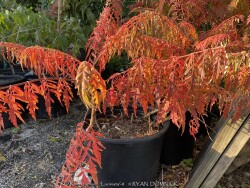

Cutleaf Staghorn Sumac, is also known as Rhus typhina 'Lanciniata'


When Tiger Eyes® sumac (Rhus typhina 'Tiger Eyes') was released, it shocked the horticulture world with unseen beauty. It started as a random mutation from cutleaf staghorn sumac (Rhus typhina 'Laciniata') that was successfully propagated. Foliage emerges in spring as a lovely chartreuse color tinged with pink new growth and contrasting leaf petioles. Growth matures to a bright yellow golden color throughout the summer. By October, especially before and around Halloween, foliage turns bright orange with hints of red. Foliage quickly freezes and drops off for the year when temperatures reach 30 degrees F. The overall architectural shape of the shrub is attractive in winter often looking like a deciduous bonsai tree up to 6 feet tall. While the original species, staghorn sumac (R. typhina), is highly aggressive and considered invasive in the garden, the Tiger Eyes cultivar (lacking as much chlorophyll) is quite a bit less aggressive from rhizomes. Some spreading will occur each year and can be clipped off with no further efforts by the plant to spread until the following year. However if soil conditions are rich and moist, some spreading can still occur. This also makes the plant more susceptible to verticillium wilt so it's best to just avoid these kind of pampered garden conditions. We recommend planting Tiger Eyes sumac on berms, tops of retaining walls and/or non-irrigated gardens in poor/dry soils. Another good micro-climate is the hot South or West side of a house; heat and drought are never an issue with no foliage burn in our zone 6a garden of Eastern Kansas. During some years with excessive humidity and rainfall, foliage can become diseased and drop off before fall color can develop but this does not seem to hurt the plant. This problem is usually avoided if planting in good air circulation in full sun or on top of a berm. Another point of advice with Tiger Eyes sumac is to allow a few nearby shoots from the root system to grow and eventually replace the mother plant. Individual top growths will usually last about 5 to 7 years before declining and dying. A plant in our display gardens has survived 15 years using this previously described method. Nowadays, there are several different ornamental shrub choices for gold summer color and while tiger eyes sumac was one of the first, it is still a great choice. Rhus typhina 'Bailtiger' TIGER EYES® if offered for sale, are original (non-propagated) plants from Bailey Nurseries Inc.
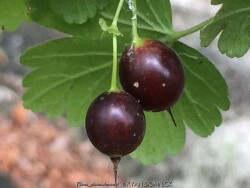

Missouri Gooseberry (Ribes missouriense) is a spreading shrub native to the north central United States including Kansas. It features green leaves that remain attractive all summer. Light yellow to whitish-green flowers are noticeable and attractive upon close inspection. Green semi-translucent berries develop in summer and ripen to a purplish-black color by late summer and early fall. Tart berries are attractive and highly edible when eaten fresh or baked into pies. Any fruits not eaten by humans are harvested by wildlife. Fall color is reddish-orange and will occur in sun or shade. This shrub eventually grows into a dense thicket 3-5' tall with small thorns or prickles. It will grow in part sun or full shade in medium to dry soils including dry-shade. In the landscape, it is commonly used as background planting on a hill or along a fence. It also makes a great barrier shrub naturally discouraging trespassers. Because of its tolerance for adverse conditions including poor soil and rock, it is often one of the last resort plants that will survive in certain areas especially in the worst of all dry-shade areas. It competes well under large shade trees and helps absorb leaf litter allowing it to break down and add nutrients back to the soil. Plants can also be planted on the Northside of a house, being extremely cold hardy with no winterkill. We do not recommend planting in small areas or in spaces that will overrun neighboring plants. It can spread by shallow horizontally growing roots but not very far. It will grow in moist rich soils but will spread quite a bit faster and grow taller. (and produce more fruit) You'll have to decide if that's desirable or not for your planting location. I have seen this plant growing exclusively in heavily shaded rocky outcroppings around Clinton lake near Lawrence Kansas with almost no other plants growing there except Coralberry(Symphoricarpos orbiculatus). Considered one of the best plants for solving your most difficult dry-shade landscape challenges.
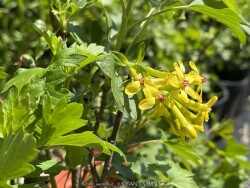



Still think yellow roses are tough to grow? Not this rebel! We evaluated yellow roses for years, looking for one that lived up to our demands for brilliant color and excellent disease-resistance. This is it! Sunny, canary yellow flowers do not fade to white, and really light up against the glossy green foliage. It is free-flowering, producing lots of buds which open to self-cleaning flowers. Superior disease-resistance makes it easy for gardeners to enjoy. Winner of an Award of Excellence from the American Rose Society. In Lawrence Kansas, performance has been impressive and low maintenance. Currently, no serious pest problems exist but we are careful not to recommend planting roses in large mass groupings in case a pest or disease like Rose Rosette Virus (RRV) becomes a problem. Mixed small plantings of roses and non-host plants may slow the spread of RRV in landscape plantings. As with most roses, thorns may be an issue with children or pets. Usually rose thorns are short and don't cause any serious injury: it creates more of a life lesson about respecting and being careful around the dangers in our world. All Proven Winners® plants are legally propagated, healthy and vigorous, true to name, and tagged with color pictures and growing information.


>>>>>All Proven Winners® plants are legally propagated, healthy and vigorous, true to name, and tagged with color pictures and growing information.


Fulgida Native Black-eyed Susan, is also known as Rudbeckia fulgida var. Fulgida
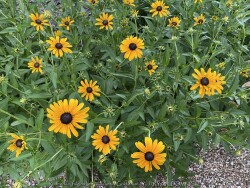

***Description for this plant available with future update!*** >>>> Good variety for customers with irrigation systems that water too much for other Black-eye Susan varieties.
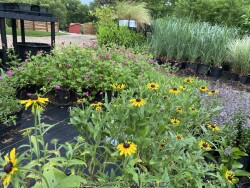

Native Black-eyed Susan, is also known as Rudbeckia hirta
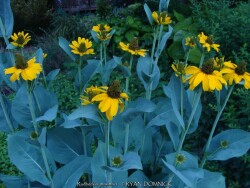

Great Coneflower / Blue-Leaf Coneflower, is also known as Rudbeckia maxima


***Description for this plant available with future update!***
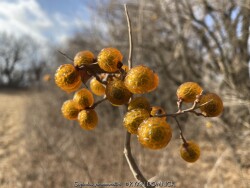

***Tree descriptions available with future update!***
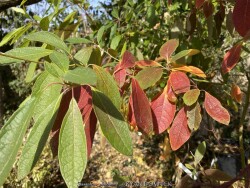



***Description for this perennial available with future update!***
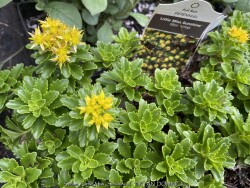

Little Miss Sunshine Sedum, is also known as Sedum 'Little Miss Sunshine'
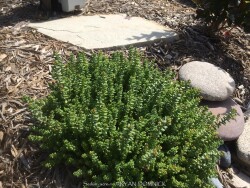

Mossy Stonecrop / Sedum, is also known as Sedum acre


Blue Corsican Sedum, is also known as Sedum dasyphyllum 'Major'
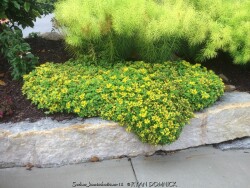

Kamtschaticum Sedum (Sedum kamtschaticum) is known for its compact mats of bright green foliage and yellow-gold flowers in the spring. Fall color turns a beautiful firey orange-red before going dormant. Kamtschaticum Sedum is native to northern China and along the Pacific coast of Siberia including the Kamchatka Peninsula with a similar climate of cold winters and hot summers. Bright green growth emerges early in the spring and spread slowly, rooting a little bit as it spreads but not aggressively. Growth is dense enough to resist most weeds. Kamtschaticum Sedum is useful as a small scale groundcover, rock garden plant, retaining wall plant, or even dry shade gardens. This tough sedum will grow in full sun to full shade in just about any soil except for wet poorly drained ones. Of all of the sedums, this is probably the most resistant to any kind of problems including root rot. I have witnessed clumps surviving and thriving for 20-30 years or more. There is really almost no maintenance with this sedum but you may choose to weed eat it in the winter for a more tidy appearance. The only slight problem is that when grown with too much water, The crown opens up as it flops over and looks slightly untidy. The flowering period is also pretty short. Considered one of the best plants for solving your most difficult dry-shade landscape challenges.
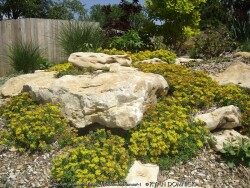

Kamtschaticum Sedum (Sedum kamtschaticum) is known for its compact mats of bright green foliage and yellow-gold flowers in the spring. Fall color turns a beautiful firey orange-red before going dormant. Kamtschaticum Sedum is native to northern China and along the Pacific coast of Siberia including the Kamchatka Peninsula with a similar climate of cold winters and hot summers. Bright green growth emerges early in the spring and spread slowly, rooting a little bit as it spreads but not aggressively. Growth is dense enough to resist most weeds. Kamtschaticum Sedum is useful as a small scale groundcover, rock garden plant, retaining wall plant, or even dry shade gardens. This tough sedum will grow in full sun to full shade in just about any soil except for wet poorly drained ones. Of all of the sedums, this is probably the most resistant to any kind of problems including root rot. I have witnessed clumps surviving and thriving for 20-30 years or more. There is really almost no maintenance with this sedum but you may choose to weed eat it in the winter for a more tidy appearance. The only slight problem is that when grown with too much water, The crown opens up as it flops over and looks slightly untidy. The flowering period is also pretty short. Considered one of the best plants for solving your most difficult dry-shade landscape challenges. Tooth-Leaf Kamtschaticum Sedum (Sedum kamtschaticum var. middendorffianum) is a shorter more drought tolerant variety with tooth-like jagged edges. The clump does not open up and flop. This variety is also more tolerant of full hot sun and shallow soils also making it an ideal roof-garden plant.
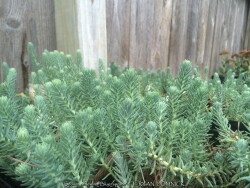

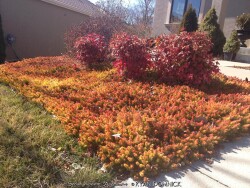

Angelina Gold & Orange Sedum, is also known as Sedum rupestre 'Angelina'
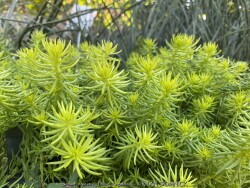

***Description for this perennial available with future update!*** NEEDS EDIT>>>>>> Sedum Prima Angelina has a denser, more compact habit and more vivid golden color than Angelina. According to Plant Delights nursery, "Sedum rupestre 'Prima Angelina' is a superb new improvement of the wildly popular, Sedum 'Angelina'. This compact, better-branched, brighter colored sport was discovered by Ohio's Jared Hughes. Sedum 'Prima Angelina' has thrived in our hot, humid summers. We particularly like that this new gem remains bright gold in cold weather, where its' parent takes on an orange cast in winter. So far, no flowers have been observed on the sport."
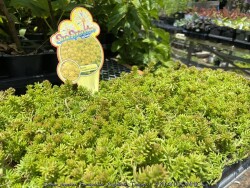

Sunsparkler Angelina's Teacup Gold & Orange Sedum, is also known as Sedum rupestre 'Sunsparkler Angelina's Teacup'
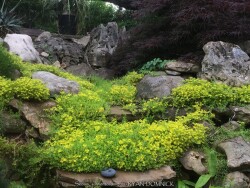

>>>>>This plant can also be in a water garden stream as long as the water is constantly moving: stagnant water is not tolerated. Considered one of the best plants for solving your most difficult dry-shade landscape challenges.


Kamtschaticum Sedum (Sedum kamtschaticum) is known for its compact mats of bright green foliage and yellow-gold flowers in the spring. Fall color turns a beautiful firey orange-red before going dormant. Kamtschaticum Sedum is native to northern China and along the Pacific coast of Siberia including the Kamchatka Peninsula with a similar climate of cold winters and hot summers. Bright green growth emerges early in the spring and spread slowly, rooting a little bit as it spreads but not aggressively. Growth is dense enough to resist most weeds. Kamtschaticum Sedum is useful as a small scale groundcover, rock garden plant, retaining wall plant, or even dry shade gardens. This tough sedum will grow in full sun to full shade in just about any soil except for wet poorly drained ones. Of all of the sedums, this is probably the most resistant to any kind of problems including root rot. I have witnessed clumps surviving and thriving for 20-30 years or more. There is really almost no maintenance with this sedum but you may choose to weed eat it in the winter for a more tidy appearance. The only slight problem is that when grown with too much water, The crown opens up as it flops over and looks slightly untidy. The flowering period is also pretty short. Considered one of the best plants for solving your most difficult dry-shade landscape challenges. Big-Leaf Kamtschaticum Sedum (Sedum takesimensis / kamtschaticum) is taller with larger leaves and larger flowers, about double that of the species.
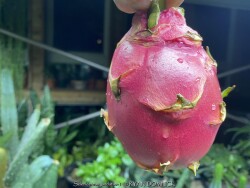

Dragon Fruit cacti are grown for delicious nutritious fruits. This tropical jungle cactus has a few requirements in order to thrive but nothing too hard. Give them bright indirect light and water only when dry. They are usually grown as a house plant in Kansas but can be moved outside if kept in part shade to shade. Leaves can sunburn but morning or filtered sun is ok! Dragon Fruit, like all true cacti, originates in the Americas. It is a sprawling or vining, terrestrial or epiphytic cactus. They climb trees and walls by use of aerial roots and can reach a height of 30 feet in the wild. Protect from temperatures below 45 degrees F and move into a bright window over the winter with no watering. As a winter house plant, it will look presentable all winter long with just a few waterings. Repotting may or may not be needed depending on how large you want the plant to grow; plants can continue to grow in the same pot for years. If repotting, make sure to use a sharp draining highly organic cactus mix with plenty of sand and perlite. This is relatively uncommon plant never seen at the big box stores and will command a higher price than most other houseplants. Plants are usually grown in hanging baskets and take up alot of space. Fruit may or may not occur in this climate; I have seen flowering but not fruit.
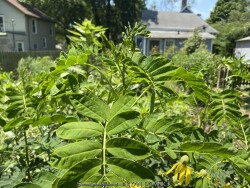

***Description for this perennial available with future update!***
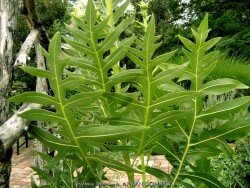

>>>>>Silphiums (Silphium laciniatum) are very long-lived perennials considered a "Once it's there, it's there forever" plant!
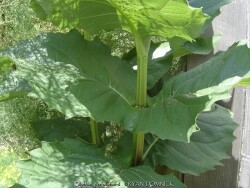

>>>>>Silphium perfoliatum (Silphium perfoliatum) >>>>>>>>is also grown as a large bog plant needing constantly moist soil rich in organic matter. As a rain garden plant, it will thrive is a depressed area in the landscape that collects rain water from a roof during spring and summer periods of rain but then >>>>>might go partially dormant if the water hole dries out completely. Considered a "Once it's there, it's there forever" plant!
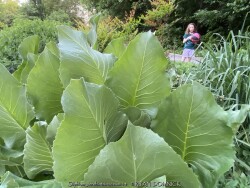

>>>>>Considered a "Once it's there, it's there forever" plant!


Bluestem Goldenrod (Solidago caesia) is a perennial wildflower with arching blue-green stems is native to the eastern and central parts of the United States and Canada. This woodland goldenrod occurs in open upland woods, shaded bluffs, slopes of wooded ravines and rocky cliffs. Yellow late-summer flowers contrast nicely with bluish purple stems. Considered one of the best plants for solving your most difficult dry-shade landscape challenges and still providing flowers if given at least a couple hours of sun or all-day dappled sun through the trees. Goldenrods are not wind-pollinated and therefore do not cause standard hay fever or allergies. This goldenrod attracts native bees, wasps and pollinating flies. Rabbit and deer resistance is good. This goldenrod has been planted in our trial gardens over 15 years ago on a dry-shade berm with 2-3 hrs of morning sun. The slowly expanding clump is virtually maintenance free, only needing trimmed in fate fall. This species does not spread by rhizomes or runners like some other goldenrods but will self-seed prolifically if you do not mulch. Bluestem Goldenrod is not well known or available in garden centers but worthy of wider scale landscape use.
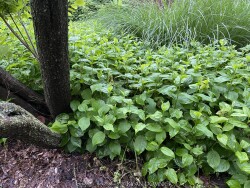

Zig Zag Goldenrod (Solidago flexicaulis) is native to the eastern and central parts of the United States and Canada. This woodland goldenrod, with erect, somewhat zig-zag stems, bears small flower heads at each node along the stem and upper leaves. The oval leaves are a rich green, pointed, and coarsely toothed. Considered one of the best plants for solving your most difficult dry-shade landscape challenges and still providing flowers. Goldenrods are not wind-pollinated and therefore do not cause standard hay fever or allergies. This goldenrod attracts butterflies. Rabbit and deer resistance is good. Zig Zag Goldenrod has been planted in our trial gardens over 10 years ago on a hill in part-sun to dry shade. The slowly expanding clump is virtually maintenance free, only needing trimmed in fate fall. Zig Zag Goldenrod is not well known or available in garden centers but worthy of wider scale landscape use.
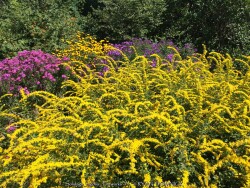

Fireworks Goldenrod (Solidago rugosa 'Fireworks') is the most garden-worthy of the goldenrods! It features dark green upright foliage. As the flower panicle matures, the expanding buds create a fine-textures cloud-like effect for about a month before the flowers open. When the flowers finally open in September, the radiating form really looks like fireworks! After flowering, the dried flower structure holds up well into fall offering winter interest until the first wet heavy snow. The species, Solidago rugosa, is native to the eastern and central parts of the United States and Canada. It is a highly adaptable goldenrod occuring in open moist areas such as low woods, meadows, old fields, pine barrens, and bogs. It is more tolerant of wet soils that other goldenrod. It prefers locations in full sun in average to moist soils that are well-drained but is adaptable to part shade or dappled shade. In Eastern Kansas, typically our 40 inches of rainfall is sufficient without extra water if planted in good soils. During the drought years in Eastern Kansas of 2011 and 2012, many Fireworks Goldenrods planted in landscapes that were not watered survived but dried up as flowers were trying to form. Goldenrods are not wind-pollinated and therefore do not cause standard hay fever or allergies. This goldenrod attracts wide variety of insects, including small bees, wasps, flies, small butterflies. Rabbit and deer resistance is good. The slowly expanding clump is virtually maintenance free, only needing trimmed in fate fall. Fireworks Goldenrod is generally very pest and disease resistant and can spread by creeping rhizomes or seed. Fireworks Goldenrod has been planted in our trial gardens over 18 years in mostly full sun with average garden soil. This is among our favorite perennials with truely 4 seasons of interest!
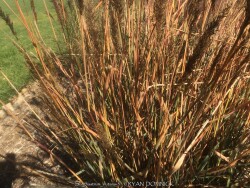

Indian Grass (Sorghastrum nutans) is easily grown in average, dry to medium, well-drained soils in full sun. It is tolerant of a wide range of soils and growing conditions but tends to flop in rich moist soils. This ornamantal grass is a tall, Kansas native, perennial, warm season grass that dominates much of the tall grass prairie extending into the Flint Hills. In fact, Indiangrass, Big bluestem, Little bluestem, and Switchgrass comprise 75% of the species in this ecosystem. It may be grown as an ornamental grass because of its attractive foliage which changes color seasonally along with its good architectural height and its interesting yellow flower/seed heads. Indian Steel Indian Grass (Sorghastrum nutans 'Indian Steel') has improved bluish green foliage that turns yellow in fall and retain some gold color throughout the winter. Feathery panicles of tan-yellow flowers appear well above the foliage in late summer to early fall adding winter interest
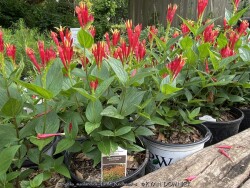

Little Red Head Spigelia / Indian Pink, is also known as Spigelia marilandica 'Little Red Head'


Ragin Cajun' Spigelia / Indian Pink, is also known as Spigelia marilandica 'Ragin Cajun'